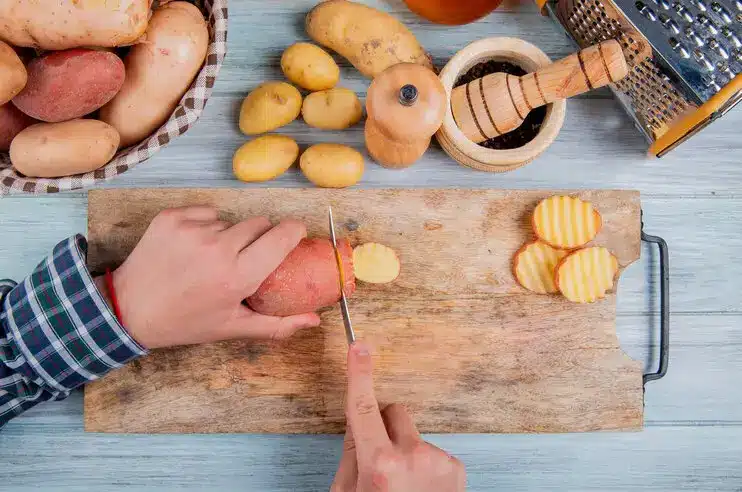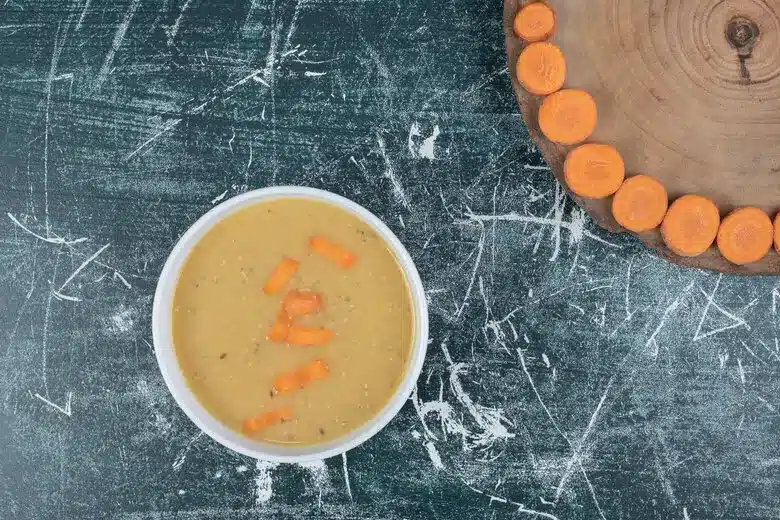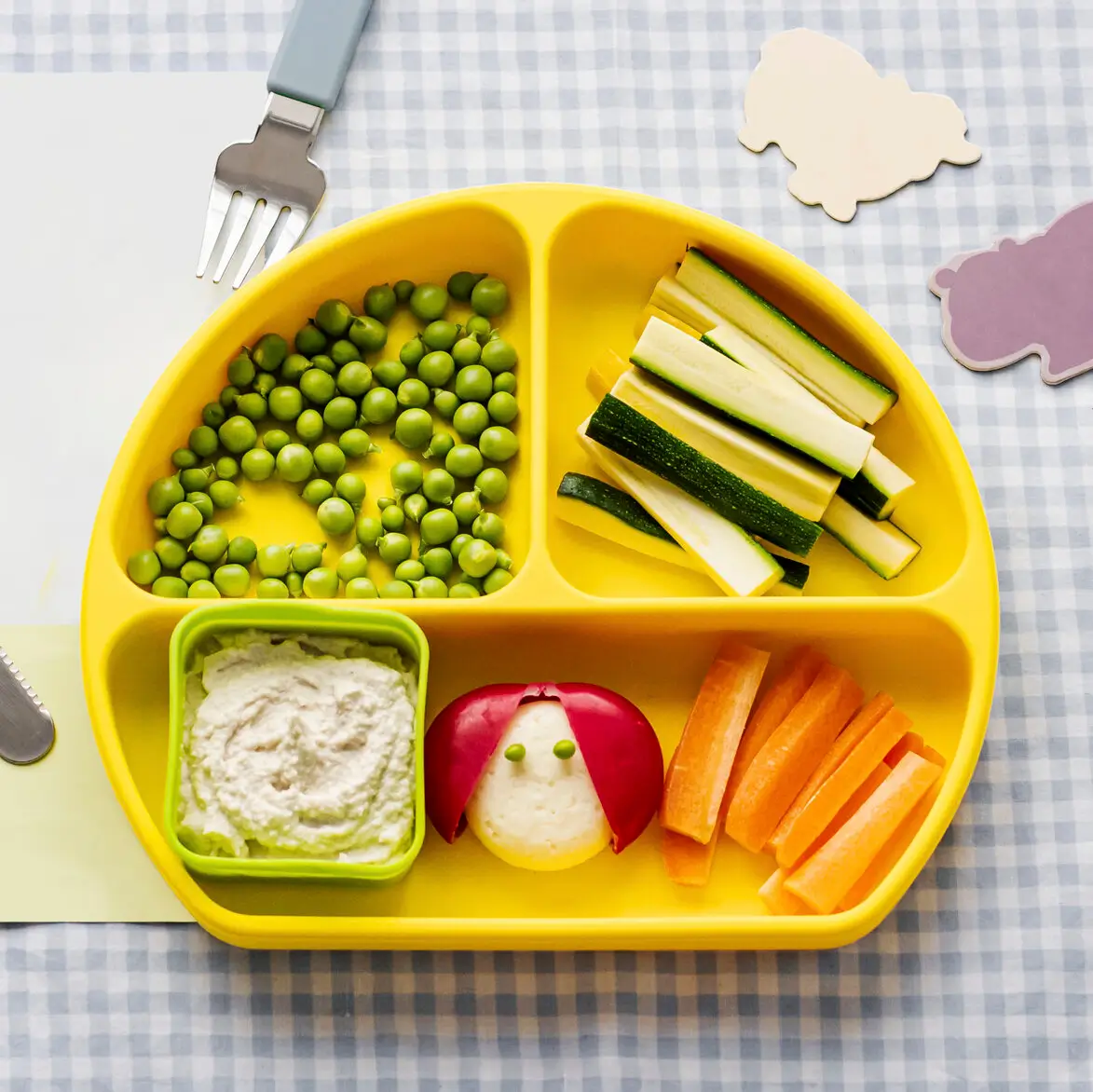sweet potato baby food keeps first meals simple, warm, and calm. Start smooth with sweet potato puree for baby, then thicken to mashed sweet potatoes for baby, and later try tiny sweet potato bites for baby. The gentle flavor brings steady energy and sits well with new tummies. Storage cubes, quick blends, and soft pancakes make busy days easier while skills grow.
Nutrition Snapshot & sweet potato benefits for infants
Orange flesh brings beta-carotene (vitamin A precursor) plus vitamin C, potassium, and fiber. These nutrients support vision, immune function, and digestion when served in small, stage-right portions. Early tastings begin with teaspoons and build to tablespoons as skills grow an easy fit for sweet potato baby food across the first year.
Families often ask if potatoes are good for infants. Yes when soft, plain, and cut to a safe size. Public guidance favors smooth textures first, then thicker and lumpy foods as swallowing and chewing improve, keeping the focus on gentle flavors and steady progress through sweet potato benefits for infants.
Sweet Potato Baby Food Preparation by Age and Stage
A steady texture ladder helps new eaters succeed. Begin smooth, then thicken, then move to tiny, soft pieces. This mirrors widely shared infant-feeding advice on texture progression and safe shapes preparation for sweet potato baby food.

4–6 months: sweet potato puree for baby
Cook until very tender (steam or bake), remove the skin, then blend with warm water, breastmilk, or formula to a silky, drip-from-the-spoon flow. Offer a spoon tip or two at first. For anyone wondering how to puree sweet potato for a baby, the rule is simple: fully soft flesh plus enough liquid to reach smooth consistency. Public guidance recommends a very smooth texture in early weeks.
7–9 months: mashed sweet potatoes for baby
Once single-ingredient purées go well, thicken a bit. Gentle lumps teach tongue control. Add a teaspoon of plain yogurt or apple purée on the same spoon if tolerated. Many infants do well with slightly thicker blends at this stage; national health advice also encourages moving forward with lumpy foods when ready. Sweet potato baby food is contain high nutrition.
10–12 months: sweet potato bites for baby
Cut very soft pieces into pea-size or smaller. Keep shapes moist and easy to squish. Mix with finely shredded chicken or well-cooked red lentils for a simple bowl. This stage also suits sweet potatoes for babies as part of easy finger-food plates and tiny rice or pasta bowls. Pediatric sources emphasize portion control, safe sizes, and calm pacing.
Tip: Whether starting with purées, baby-led shapes, or a mix, maintain soft textures and small sizes. A calm setup reduces gagging and helps learning.
Simple Preparation Methods for sweet potato baby food
Pick one core method and repeat weekly. Consistency saves time and keeps quality even.
Bake
Prick and roast whole at 400°F (205°C) until a fork slides in without effort. Scoop flesh; mash or blend. Roasting develops natural sweetness and deep color great for early fans of sweet potato baby food.
Steam
Peel, cube, and steam until mashable. Steaming holds moisture, which makes blending easier for sweet potato puree for babies.
Microwave
Pierce, microwave in short bursts, turn often, and check for full softness. Then mash or blend to the right flow. All three methods reach the same goal: fully tender flesh that blends to a safe texture for sweet potato baby food. For families comparing routes, cooking method matters less than final softness and clean handling.
Flavor Combinations — mild blends that work
Keep the vegetable as the main flavor and build gentle companions around it:
- Fruit lifts: apple, pear, banana
- Veg partners: carrot or pumpkin
- Protein helpers: plain yogurt, well-cooked red lentils, shredded chicken
- Warm spice: a pinch of cinnamon or nutmeg (no heat)
These pairings keep the taste friendly and bring variety without stealing the show. Dietetic and public guidance supports single-ingredient starts, then gradual combos as skills and tolerance grow.
Texture Progression & Safety
Early foods work best as very smooth blends. With practice, introduce thicker textures and then small, soft pieces that squish between fingers. Expect some gagging during learning; short pauses and calm pacing help. National guidance highlights matching texture to development, avoiding round/firm hazards, and feeding small portions slowly.
- Thin: glossy, pourable purée
- Thicker: holds light peaks on the spoon
- Soft pieces: pea-size or smaller, mashable with gums
Serving Ideas by Time of Day with sweet potato baby food
Breakfast (easy starts). Pair a few spoons of purée with baby oatmeal. For variety, sweet potato pancakes baby turn leftovers into tender mini-cakes that freeze well and fit toddler breakfast ideas with sweet potato baby food.
Lunch (mix and match). Blend a thicker mash with plain yogurt and a dusting of cinnamon. For finger-food plates, add avocado slices or banana pieces.
Dinner (comfort bowls). Stir a small spoon of purée into rice or tiny pasta. A baby sweet potato recipe with lentils makes a quick, warm bowl that scales to the adult table too.
Storage for sweet potato baby food
Good storage protects quality and limits waste Sweet Potato Baby Food.

- Refrigerate purées in airtight containers for about 2–3 days.
- Freeze in ice-cube trays or small tubs for up to 6–8 months for strained fruits/veg; label and date.
- Thaw in the fridge; reheat gently and thin as needed. Discard leftovers that returned to the spoon. These ranges align with national food-safety references.
Batch days make weekdays easy. Freeze single-ingredient cubes first; blend after thawing to control thickness and flavor balance. Public health advice also reminds families to keep baby foods free of added salt and sugar.
Shopping & Selecting sweet potatoes for babies
Pick the best roots
Firm, smooth, sprout-free picks suit sweet potatoes for babies; purple or white types also work for sweet potatoes for babies.
Wash and peel for purées
Rinse well. Peel before cooking for silk-smooth sweet potato baby food; older stages can keep some peel and blend longer.
Tools that speed safe prep
A sharp peeler, stable board, and steady blender or ricer make sweet potato baby food fast and consistent.
Baby-led shapes (soft and squishy)
For potato for infants or Sweet potato for infants, cook spears until they squish easily, then cut smaller as skills improve.
Why give sweet potato baby food to a baby?
Gentle energy for growth
Sweet potato for babies offers steady carbs that help fuel play and learning. The mild taste makes first bites easy for new eaters is sweet potato baby food.
Vitamins that matter
Orange flesh is rich in beta-carotene, a source of vitamin A for eyes and skin key sweet potato benefits for infants. It also brings vitamin C and potassium for everyday health.
Easy on tiny tummies
Soft fiber supports regular digestion. Silky sweet potato puree for baby is a calm start; later, mashed sweet potatoes for baby add gentle lumps without stress.
Safe textures that build skills
Moving from smooth purée to pea-size sweet potato bites for babies helps practice chewing and self-feeding. Shapes stay soft and squishy for safety.
Flexible for busy days
The same batch works at breakfast, lunch, and dinner. Leftovers become sweet potato pancakes for older stages and fit many toddler breakfast ideas without extra shopping.
Stores well for the week
Purée freezes in small cubes, so sweet potatoes for babies are always ready. Thaw, warm gently, and thin or thicken to match today’s texture.
Pairs nicely with other foods
Simple blends of apple, yogurt, or lentils add variety while keeping sweet potato baby food the main flavor. This supports balanced meals as portions grow.
Serving Boards & Bites ideas that grow with skills
- Soft patties: Lightly pan-warm tender patties for sweet potato bites for baby (no added salt).
- Tiny bowls: Stir purée into rice or quinoa for sweet potatoes for babies who are moving toward shared family meals.
- Weekend fun: Keep a batch of sweet potato pancakes baby for quick brunch plates that also fit toddler breakfast ideas.
sweet potato baby food Recipe Cards

Early Spoon — sweet potato for baby
Ingredients: 1 medium sweet potato; warm water or milk for thinning
Method: Bake or steam until very tender. Remove skin. Blend with warm liquid until glossy and thin enough to drip from the spoon. Serve 1–2 teaspoons.
Storage: 2–3 days in the fridge; longer in the freezer as cubes.
Middle Stage — mashed sweet potatoes for baby
Ingredients: 1 baked sweet potato; 1–2 tsp plain yogurt (optional)
Method: Mash until mostly smooth with a few soft lumps. Stir in yogurt for creaminess. Serve 2–4 tablespoons, watching cues.
Finger-Food Plate — sweet potato bites for baby
Ingredients: Very soft cubes; optional finely shredded chicken or well-cooked lentils
Method: Cut pea-size or smaller. Serve moist and warm. Pair with banana or avocado pieces for variety.
These shapes follow public guidance on moving from purées to lumpy textures to small, soft pieces as skills advance.
Baby sweet potato recipe simple flavor combos
Apple swirl (for sweet potato puree for baby)
Purée plus a spoon of apple makes a cozy bowl with mild sweetness. Keeps sweet potato baby food as the lead flavor.
Carrot mix (color and balance for sweet potato baby food)
Half carrot, half sweet potato adds brightness without overpowering. A simple sweet potato recipe for babies that stays familiar.
Yogurt + spice (warm, creamy baby sweet potato recipe)
Thicker mash with plain yogurt and a tiny pinch of cinnamon. Creamy texture supports steady spoonful.
Lentil boost (protein-friendly sweet potato recipe for baby)
Stir purée into well-cooked red lentils for a soft, balanced bowl. Gentle flavor fits early blends.
These blends fit the “single ingredient first, then add” approach used by pediatric groups.
Texture & Safety Refresher for potato for infants
- Start very smooth; thicken with practice.
- Keep shapes small and soft for finger foods.
- Expect gagging while learning; pause and try again later.
- Offer small portions and slow pacing.
- Keep added salt and sugar out of baby batches.
Brunch ideas toddler breakfast ideas with sweet potato
Mini-cakes: Mix leftover purée with an egg and a spoon of oats, cook as small pancakes on low heat until very tender. Cut into tiny squares for older infants. These keep well in the freezer and also fit toddler breakfast ideas on school days.
Warm bowls: Stir purée into oatmeal with a dusting of cinnamon. For older eaters, add mashed banana for extra sweetness without sugar.
Lunch & Dinner bowls that everyone can share
Creamy mash bowl: mashed sweet potatoes for baby plus plain yogurt and a small sprinkle of cinnamon.
Protein mix: Stir purée into red lentils or soft beans.
Family pasta: Mix a spoon of purée into tiny pasta for color and comfort.
When meals line up across ages, kitchens calm down. This is the everyday value of sweet potato baby food done simply.
Safe storage sweet potato puree for baby
Food-safety references lay out clear fridge/freezer windows for homemade baby foods and strained fruits/vegetables (2–3 days refrigerated; up to 6–8 months frozen), along with shorter timelines for meats and combos. Label, date, and store in small portions; thaw in the fridge; reheat gently and thin as needed.
Public health organizations also encourage families to move from smooth to lumpier textures once the child shows readiness signs, keeping meals free of added salt/sugar and focusing on clean prep and storage.
Troubleshooting & Comfort
- Refusal today? Try again at the next mealtime with a thinner blend.
- Texture mismatch? Adjust liquid or simmer to reduce water.
- Constipation week? Smaller portions; pair with pear purée later in the day.
- Mess stress? Keep short sessions, two clothes, and a small mat under the chair.
Most hurdles fade with steady practice and simple adjustments that keep the plan friendly.
FAQ
Q1. When should sweet potato baby food start?
Around 4–6 months after checking readiness signs with a clinician. Begin with smooth purée and small portions.
Q2. What’s the best method for how to puree sweet potatoes for a baby?
Bake or steam until very soft, remove skin, blend with warm water or milk until glossy and pourable.
Q3. Are sweet potatoes for babies safe as finger food?
Yes, when cut into tiny, soft pieces that squish with light pressure. Keep sizes small and the texture moist.
Q4. Any easy baby sweet potato recipe ideas for busy nights?
Try a warm bowl of purée stirred into red lentils, or a quick sweet potato recipe for baby that pairs purée with yogurt and a pinch of cinnamon.
Q5. Do sweet potato pancakes baby work for brunch and toddler breakfast ideas?
Yes. Tender mini-cakes freeze well and reheat fast. Cut into tiny squares for older infants.
Q6. Is potato for infants appropriate, and is potato good for infants nutritionally?
Soft, plain potato fits infant meals. Sweet varieties also bring beta-carotene and vitamin C. Portions stay small and textures soft.
Q7. How long can sweet potato baby food stay in the fridge or freezer?
Generally 2–3 days in the refrigerator and up to 6–8 months frozen for strained fruits/veg. Thaw in the fridge; reheat gently; discard leftovers that touched the spoon.
Q9. How does Sweet potato for infants fit with allergen planning?
Start single-ingredient purées. Add other foods one at a time and progress to gentle blends. Keep textures soft and sizes small.
Conclusion
With soft textures, small portions, and a simple prep rhythm, sweet potato baby food turns daily meals into easy wins. Bake or steam once, store safely, and serve in ways that match each stage. Gentle flavors, mild blends, and freezer cubes keep the plan friendly. As skills grow, bowls, bites, and pancakes carry the same comfort into toddler days one warm spoon at a time



